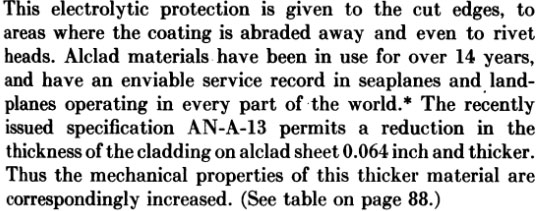Mark
I have looked at most of your examples and they certainly show the AN-A-13 designation has a "foggy"history. I may have missed it but were any of the markings you identified on the exterior face of the aircraft and so far as is possible to tell do they appear to have been rolled on with the direction of the grain of the aluminum sheet or stamped on without regard to the grain? As far as I have read the grain can be identified on unpolished sheets by the direction of small scratches from the rollers that formed the sheets.
Matt, comparing the 1941 edition of the Alcoa Co. handbook, "Aluminum in Aircraft" with the 1943 edition reveals when the AN-A-13 designation came into use. The 1943 edition tells of the
"...recently issued specification AN-A-13...", the 1941 edition makes no mention of it.
There are a few examples in that list showing Alclad markings on the exterior side - on B-17s if I recall.
I believe it's safe to say that all 'machine rolled' ink stamps are parallel to the grain. I've never seen an example of the distinctive font found on 2-2-V-1 in a 'hand-stamped' label. As Ric reported in 1992,
"An exhaustive search of aircraft of World War Two and earlier vintage produced only three examples of aluminum bearing these exact markings:...In all three cases, the entire sequence of labeling reads:
ALCOA T. M. .032" ALCLAD 24 S – T 3 AN – A – 13."The Alcoa engineer Ric spoke with in 1996 was wrong about the meaning of AN-A-13. I believe he was wrong about the hand-stamping concept too.
http://tighar.org/smf/index.php/topic,1426.msg30572.html#msg30572The 1941 edition- [see page 9]
http://babel.hathitrust.org/cgi/pt?id=mdp.39015006056306;view=1up;seq=13The 1943 edition- [see page 9]
http://babel.hathitrust.org/cgi/pt?id=uc1.b4444813;view=1up;seq=5This is an image from page 9 of the 1943 edition Ric posted earlier.

